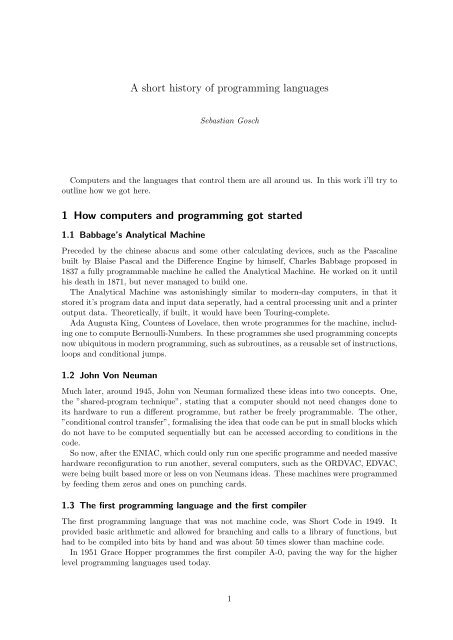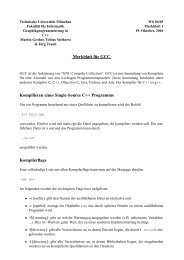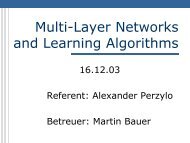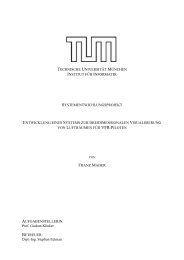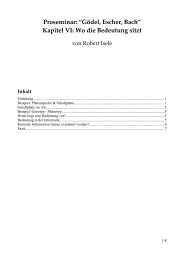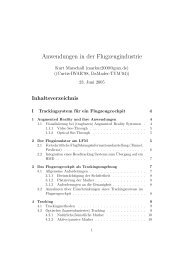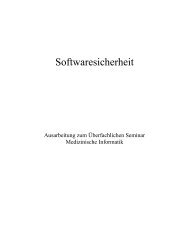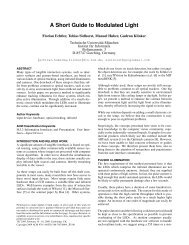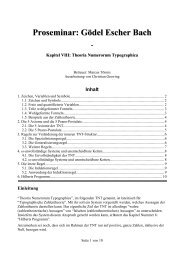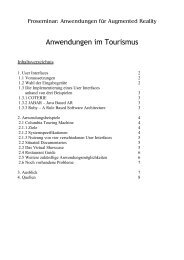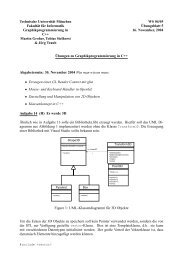A short history of programming languages 1 How computers and ...
A short history of programming languages 1 How computers and ...
A short history of programming languages 1 How computers and ...
You also want an ePaper? Increase the reach of your titles
YUMPU automatically turns print PDFs into web optimized ePapers that Google loves.
A <strong>short</strong> <strong>history</strong> <strong>of</strong> <strong>programming</strong> <strong>languages</strong><br />
Sebastian Gosch<br />
Computers <strong>and</strong> the <strong>languages</strong> that control them are all around us. In this work i’ll try to<br />
outline how we got here.<br />
1 <strong>How</strong> <strong>computers</strong> <strong>and</strong> <strong>programming</strong> got started<br />
1.1 Babbage’s Analytical Machine<br />
Preceded by the chinese abacus <strong>and</strong> some other calculating devices, such as the Pascaline<br />
built by Blaise Pascal <strong>and</strong> the Difference Engine by himself, Charles Babbage proposed in<br />
1837 a fully programmable machine he called the Analytical Machine. He worked on it until<br />
his death in 1871, but never managed to build one.<br />
The Analytical Machine was astonishingly similar to modern-day <strong>computers</strong>, in that it<br />
stored it’s program data <strong>and</strong> input data seperatly, had a central processing unit <strong>and</strong> a printer<br />
output data. Theoretically, if built, it would have been Touring-complete.<br />
Ada Augusta King, Countess <strong>of</strong> Lovelace, then wrote programmes for the machine, including<br />
one to compute Bernoulli-Numbers. In these programmes she used <strong>programming</strong> concepts<br />
now ubiquitous in modern <strong>programming</strong>, such as subroutines, as a reusable set <strong>of</strong> instructions,<br />
loops <strong>and</strong> conditional jumps.<br />
1.2 John Von Neuman<br />
Much later, around 1945, John von Neuman formalized these ideas into two concepts. One,<br />
the ”shared-program technique”, stating that a computer should not need changes done to<br />
its hardware to run a different programme, but rather be freely programmable. The other,<br />
”conditional control transfer”, formalising the idea that code can be put in small blocks which<br />
do not have to be computed sequentially but can be accessed according to conditions in the<br />
code.<br />
So now, after the ENIAC, which could only run one specific programme <strong>and</strong> needed massive<br />
hardware reconfiguration to run another, several <strong>computers</strong>, such as the ORDVAC, EDVAC,<br />
were being built based more or less on von Neumans ideas. These machines were programmed<br />
by feeding them zeros <strong>and</strong> ones on punching cards.<br />
1.3 The first <strong>programming</strong> language <strong>and</strong> the first compiler<br />
The first <strong>programming</strong> language that was not machine code, was Short Code in 1949. It<br />
provided basic arithmetic <strong>and</strong> allowed for branching <strong>and</strong> calls to a library <strong>of</strong> functions, but<br />
had to be compiled into bits by h<strong>and</strong> <strong>and</strong> was about 50 times slower than machine code.<br />
In 1951 Grace Hopper programmes the first compiler A-0, paving the way for the higher<br />
level <strong>programming</strong> <strong>languages</strong> used today.<br />
1
2 Significance <strong>and</strong> characteristics <strong>of</strong> higher-level <strong>programming</strong><br />
Higher level <strong>programming</strong> lets the programmer concentrate on solving a problem without<br />
having to worry to much about a <strong>computers</strong> hardware. A drawback though is the slower<br />
computing time, as the code will first be translated into machine code <strong>and</strong> then be run.<br />
2.1 FORTRAN - 1957<br />
The first big language was Fortran (FORmula TRANslation) which was mainly intended<br />
<strong>and</strong> used for scientific computing, the military projects <strong>and</strong> later the Space Program being<br />
prominent examples. It was the first language to introduce data types, such as boolean,<br />
integer, real <strong>and</strong> double-precision numbers. It spawned a whole lot <strong>of</strong> dialects which adapted<br />
the language <strong>and</strong> kept it up to date in the course <strong>of</strong> the years <strong>and</strong> is widely used up until<br />
today.<br />
2.2 COBOL - 1959<br />
Whilst Fortran was great for number crunching it did lack a proper I/O, <strong>and</strong> in 1959 the<br />
Conference on Data Systems <strong>and</strong> Languages (CODASYL) got together <strong>and</strong> agreed on Cobol<br />
as a language for the buisiness market. It only recognised numbers <strong>and</strong> strings <strong>of</strong> text, which<br />
were grouped together into arrays providing for good data h<strong>and</strong>ling.<br />
Although widely criticized for being just a <strong>short</strong> term solution to problems perceived in the<br />
1950’s <strong>and</strong> significantly better <strong>languages</strong> existing on the market today, the language is still in<br />
widespread use, due to legacy systems having been dragged along from the very beginning.<br />
2.3 ALGOL - 1958<br />
Implemented in a formal grammar, the Backus-Naur-Form, Algol is the ancestor <strong>of</strong> pretty<br />
much every <strong>programming</strong> language in use today, in that it is the first block-structured language.<br />
Originally intended for scientific computing it soon got replaced by the <strong>languages</strong> it<br />
spawned.<br />
2.4 Lisp - 1958<br />
Lisp is <strong>short</strong> for List Processing <strong>and</strong> is quite different from the other <strong>languages</strong> <strong>of</strong> that time,<br />
or any time even, in that it relies heavily on linked lists as the main data structure. Even the<br />
source code itself is made up <strong>of</strong> lists, thus making the language easy to manipulate.<br />
Lisp is closely linked to AI research.<br />
3 S<strong>of</strong>tware crisis <strong>and</strong> beyond<br />
Up until now all the computing was done on huge <strong>computers</strong> taking up whole rooms in<br />
universities <strong>and</strong> big companies, like the Univacs or later the PDP series. Personal <strong>computers</strong><br />
turned up around 1980 bringing new interests <strong>and</strong> needs.<br />
2
3.1 S<strong>of</strong>tware crisis<br />
As hardware power was growing exponetially, following Moore’s Law, s<strong>of</strong>tware programmers<br />
struggled to keep up. More <strong>and</strong> more lines <strong>of</strong> code were being written for increasingly complex<br />
projects. This led to the s<strong>of</strong>tware crisis <strong>of</strong> the 1960’s <strong>and</strong> early 1970’s when more <strong>and</strong> more<br />
s<strong>of</strong>tware projects began to run over-budget <strong>and</strong> over-time, as well as being <strong>of</strong> poor quality.<br />
In 1968 Friedrich Bauer adresses the problem at a NATO Conference in 1968 in Garmisch<br />
<strong>and</strong> calls for s<strong>of</strong>tware engineering, much similar to project managemant in classical engineering<br />
fields. The most interesting proposal from a <strong>programming</strong> language point <strong>of</strong> view being<br />
modularization <strong>of</strong> code for easier maintenance, since only parts <strong>of</strong> the s<strong>of</strong>tware have to be<br />
rewritten, if the need arises. Also modularization encourages <strong>and</strong> supports collaboration<br />
between programmers on s<strong>of</strong>tware projects.<br />
These concepts have found their way into todays <strong>languages</strong>, which pretty much all support<br />
modularization in some form or other.<br />
3.2 Object Orientation<br />
Object-oriented <strong>programming</strong> dates back to the 1960’s but only got popular in the early<br />
1990’s. It is a special type <strong>of</strong> modularization intended to ensure a programmes quality.<br />
Object-oriented <strong>programming</strong> <strong>languages</strong> share a few common concepts which would define<br />
them:<br />
- Class: a class defines the traits shared by all the objects which can be instances <strong>of</strong> that class<br />
- Object: an object is an instance <strong>of</strong> such a class<br />
- Method: a method is the ability <strong>of</strong> such an object<br />
Other concepts in OOP include message passing, inheritance <strong>and</strong> encapsulation.<br />
3.3 Home Computers<br />
Home <strong>computers</strong> came into use in the late 1970’s, allowing loads <strong>of</strong> people, who would else<br />
would have never seen a computer, to programme on their own. This led to the rise <strong>of</strong><br />
<strong>languages</strong> otherwise not notable such as Pascal, which was intended as a educational tool, with<br />
very strict syntax but gathered widespread adoption outside expectations, <strong>and</strong> the keeping <strong>of</strong><br />
Basic which’s use was declining, but which spread again after versions <strong>of</strong> Basic were distributed<br />
with pretty much everyhome computer.<br />
4 Languages Today<br />
Nowadays thous<strong>and</strong>s <strong>of</strong> <strong>programming</strong> <strong>languages</strong> are being used, some <strong>of</strong> the first ones still,<br />
dialects <strong>of</strong> the early <strong>languages</strong>, newer <strong>languages</strong> designed with the knowledge <strong>of</strong> the last 50<br />
years, or even completely new <strong>languages</strong> are still being proposed <strong>and</strong> implemented. The world<br />
is an ever changing place with new problems, ideas <strong>and</strong> hardware environments sprouting up<br />
every other second.<br />
Choosing the best for a given s<strong>of</strong>tware project, would depend on the scope <strong>of</strong> the project,<br />
the inclination <strong>of</strong> the programmer, the existence <strong>of</strong> legacy s<strong>of</strong>tware which would have to be<br />
considered, as well as a whole other load <strong>of</strong> reasons. I will now try <strong>and</strong> detail some <strong>of</strong> the<br />
better-known <strong>languages</strong> <strong>of</strong> today.<br />
3
4.1 C<br />
C used a lot <strong>of</strong> concepts known from - but is not a successor <strong>of</strong> - Pascal, although a lot harder<br />
to read <strong>and</strong> more effective in terms <strong>of</strong> computing speed. It was mainly associated, but not<br />
limited to, the UNIX operating system creating a synergy effect in acceptance, helping both<br />
projects greatly. Since its inception it has been it has had a range <strong>of</strong> successors such as C<br />
with Classes in 1980 <strong>and</strong> later, based on that, C++ which implemented the ideas <strong>of</strong> OOP<br />
<strong>and</strong> made it compatible for today.<br />
4.2 Java<br />
Designed by Sun Microsystems in 1990 <strong>and</strong> intended to be very portable, by not allowing<br />
dialects <strong>and</strong> being compiled into bytecode which then runs on a Java Virtual Machine. Java<br />
supports a whole load <strong>of</strong> modern <strong>programming</strong> concepts but omits others, such as pointers,<br />
in favor <strong>of</strong> security Java has got a range <strong>of</strong> <strong>short</strong>comings, such as its low speed <strong>and</strong> its C-like<br />
code which is not very readable.<br />
4.3 Domainspecific <strong>languages</strong><br />
In the course <strong>of</strong> ongoing specializations in the buisiness <strong>and</strong> computing world <strong>programming</strong><br />
<strong>languages</strong> have reflected this trend by Nowadays, almost as <strong>of</strong>ten as a general-purpose languague,<br />
a domainspecific language will be used to solve a little problem. Often these <strong>languages</strong><br />
will be used side by side in a s<strong>of</strong>tware project. Such <strong>languages</strong> include database-query <strong>languages</strong>,<br />
like sql, graphical <strong>and</strong> printing <strong>languages</strong>, such as Postscript, scripting <strong>languages</strong> such<br />
as PHP <strong>and</strong> many more.<br />
5 Biblography<br />
- Klaus Bothe - Von Algol nach Java - Kopntinuitt und W<strong>and</strong>el in Programmiersprachen -<br />
2006<br />
- The Language Center - http://www.engin.umd.umich.edu/CIS/course.des/cis400/index.html<br />
accessed on 25.05.07<br />
- The <strong>history</strong> <strong>of</strong> <strong>programming</strong> <strong>languages</strong> - http://www2.lv.psu.edu/ojj/courses/ist-240/reports/spring2001/facb-bc-kf/<strong>history</strong>index.html<br />
accessed on 25.05.07<br />
- pretty much all <strong>of</strong> Wikipedia - http://en.wikipedia.com accessed 25.05.07<br />
4


